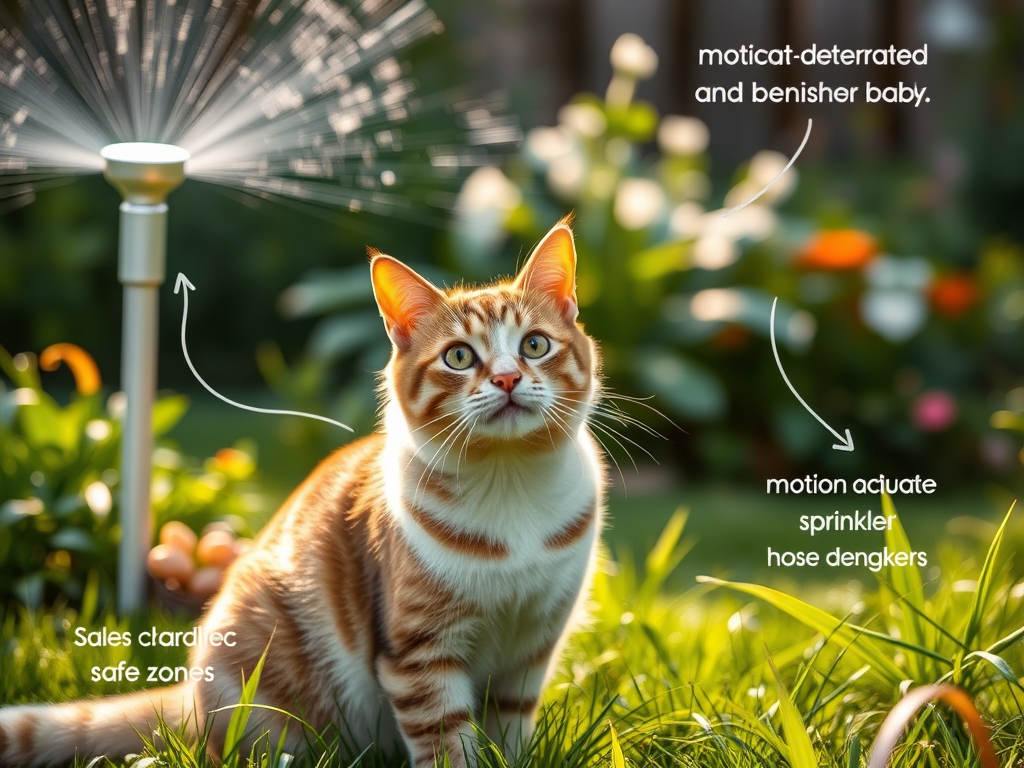Effective Strategies for Reducing Your Cat’s Hunting Behavior
Reducing Your Cat's Hunting Impact on Wildlife: Cats are instinctive hunters, a behavior that has been ingrained in them through their evolutionary history. While this instinct is natural, it is possible to create a secure indoor environment that nurtures their hunting tendencies while safeguarding local wildlife. By thoughtfully designing engaging spaces and activities that stimulate their senses and instincts, you can ensure that your furry companion remains mentally engaged and physically satisfied without endangering the lives of unsuspecting animals outside your home.
Investing in interactive toys can greatly enhance your cat's indoor hunting experience and keep them entertained for hours. Options such as feather wands, laser pointers, and motorized mice can effectively mimic the behaviors of prey, allowing your feline to track, pounce, and leap—actions that provide critical mental stimulation and physical activity. These engaging toys not only keep your cat entertained but also contribute positively to their overall health by helping them expend excess energy in a constructive manner, reducing boredom-related behaviors.
Transform your living space into a feline-friendly adventure zone by setting up obstacle courses filled with boxes, tunnels, and shelves. This DIY jungle gym encourages exploration and promotes physical activity, allowing your cat to climb, jump, and investigate various environments. Given their natural curiosity, providing diverse spaces for exploration can evoke their wild instincts, making them feel as if they are on an exciting adventure in their own personal safari.
Never underestimate the value of puzzle feeders in your cat's routine. These innovative devices not only challenge your cat mentally but also simulate the effort they would typically exert while hunting. By incorporating treat-dispensing puzzles into your cat's feeding schedule, you can keep their minds sharp while providing them with a fun and rewarding challenge. This strategy not only entertains your feline but also encourages healthier eating habits as they learn to work for their treats, effectively channeling their hunting instincts.
Make playtime a vital part of your daily routine. Engaging in social interaction through play is essential for strengthening the bond between you and your cat. Schedule regular play sessions using the same toys that they enjoy during solo playtime. This shared activity not only alleviates any pent-up energy or frustration your cat may experience but also enhances your connection, making playtime a satisfying and enjoyable experience for both of you.
Creating a stimulating indoor environment for your cat is not only achievable but can also be a rewarding endeavor. With a bit of creativity and commitment, your home can evolve from a simple shelter into an engaging landscape that satisfies their natural hunting instincts while keeping them safe from external threats. By planning thoughtfully, you can cultivate a happy, healthy, and fulfilled indoor cat.

Leash Training: Open Up New Outdoor Experiences for Your Cat
Embracing leash training can unlock a world of safe exploration for your cat. Though walks are often associated with dogs, cats can also relish outdoor adventures with the right training and a bit of patience. By introducing your feline companion to a harness and leash, you can allow them to enjoy nature while ensuring their security at all times.
Start the leash training process with a well-fitting harness that offers comfort for your cat. It’s important to let your pet get accustomed to the harness before attempting to put it on them. Allow them to sniff and examine the harness, as this will help to alleviate any anxiety. Gradually acclimating them to the harness at their own pace fosters positive associations, making the experience smoother for both of you.
Once your cat shows comfort with the harness, attach a lightweight leash and practice walking indoors. This familiar environment will help them adjust to the sensation of wearing a leash and build their confidence. Take your time and be prepared for some initial resistance; patience and gentle encouragement are key to helping your cat adapt to this new experience.
When venturing outside for the first time, choose a calm, secure area, such as your backyard or a quiet park. Ensure that the location has minimal traffic and distractions to make your cat feel secure. Start with short outdoor sessions to avoid overwhelming your pet, gradually increasing the duration as they become more comfortable with their new surroundings.
Supervised outdoor time enriches their lives, allowing them to enjoy the sights, sounds, and scents of nature without posing a threat to local wildlife. Imagine the joy on your cat's face as they encounter new experiences in a safe environment. This bonding time not only enhances their quality of life but also strengthens your relationship with them.
Real-life stories from fellow cat owners can serve as inspiration. Many have shared initial doubts about whether their cats would adapt to leash walking, but consistency and positive reinforcement made all the difference. Celebrate each small victory as a step toward broadening your cat's horizons while ensuring their safety.
By integrating leash training into your cat's routine, you are promoting a balance of outdoor enjoyment and wildlife protection. This thoughtful approach allows your cat to explore safely while fostering a sense of security in their environment.
Designing Secure Outdoor Spaces: The Advantages of Catios
Outdoor cat enclosures, commonly known as catios, offer an excellent solution for adventurous felines yearning for outdoor experiences without the associated dangers. These secure spaces allow your feline companions to relish the outdoors while ensuring their safety and protecting local wildlife from potential harm.
Building or purchasing a catio can be tailored to your available space and budget. Options range from simple balcony enclosures to more elaborate backyard constructions. The primary focus should be on crafting an escape-proof structure, as safety is paramount when providing a secure environment for your cat.
When designing your catio, consider incorporating multiple levels and cozy hiding spots. Cats thrive in environments that offer vertical spaces and places to retreat. By adding platforms, ramps, and hammocks, you can transform a basic enclosure into an engaging paradise that mimics their natural habitat, providing hours of entertainment and exploration.
Enhancing the sensory experience within the catio can also be advantageous. Introduce elements such as cat grass, scratching posts, or natural logs to create a stimulating environment filled with diverse textures and scents. This sensory enrichment can keep your cat engaged and satisfied, allowing them to enjoy the pleasure of being outdoors in a controlled setting.
Regular maintenance is essential for ensuring the safety of your catio. Routinely inspect for any signs of wear and tear, including the integrity of the mesh, the structure itself, and the locks. Cats are naturally curious and may test the boundaries of their enclosure, so keeping it in excellent condition is vital for their safety and well-being.
With a catio, your feline friend can bask in the sun, climb, and observe wildlife without posing a threat to local ecosystems. They can enjoy the fresh air and watch birds from the safety of their outdoor haven, remaining content while wildlife continues to thrive in their natural habitat.

Proven Behavioral Training Methods to Reduce Hunting Instincts
Teaching your cat to minimize hunting behaviors may seem daunting, but with the right techniques, it can be a manageable task. The first step involves understanding their natural instincts and the behaviors that drive them to hunt, which is crucial for implementing effective training strategies tailored to your cat’s unique personality.
Utilizing technology can significantly support your training efforts. Consider employing motion-activated deterrents, such as sprinklers or noise-makers, to create boundaries that discourage hunting without disrupting other activities in your yard. Strategically zoning your outdoor space into cat-safe areas can effectively redirect your cat's attention away from potential prey.
Positive reinforcement is a cornerstone of modifying your cat's behavior. Reward them for non-hunting actions with treats or affection. For example, if your cat responds to your call or refrains from pursuing a potential target, offer them a delicious treat or extra affection. This method encourages them to repeat desirable behaviors while diminishing their instinctive urge to hunt.
Incorporating clicker training can also be a powerful strategy. This technique involves associating a distinct sound with positive actions, enabling your cat to connect their behavior with rewards. By clicking when they exhibit desired behavior, you can reinforce good habits and clarify expectations, making it easier for your cat to learn.
For more personalized guidance, consider consulting with feline behavior specialists. They can provide tailored advice and insights that address specific challenges, helping you and your cat coexist harmoniously while respecting local wildlife and the ecosystem.
The goal of using deterrents and training isn’t to punish but to guide your cat towards behaviors that prioritize their safety and environmental stewardship. With consistency and patience, you can successfully redirect their instincts, leading to safer outdoor interactions for both your cat and local wildlife.
Nutritional Strategies to Reduce Hunting Drives in Cats
The type of food you provide and the methods you employ for feeding can greatly impact your cat's hunting instincts. Interestingly, a well-fed cat may still exhibit hunting behaviors; however, the manner in which you feed them can play a role in mitigating this drive. Understanding your cat's dietary needs is crucial for ensuring they are satisfied while curbing their instinctual urges.
Free feeding, where food is available at all times, may not be suitable for every cat. Instead, consider establishing a feeding schedule with set meal times. By creating predictable mealtimes, your cat may be less inclined to hunt, as they learn to associate feeding with specific times of the day, ultimately reducing their need to seek out prey.
Implementing interactive feeding strategies can be transformative for your cat's behavior. Utilizing food puzzles or dispensers can replicate the act of hunting, requiring your cat to ‘work’ for their meals. This approach not only keeps them mentally and physically stimulated but also channels their energy positively, allowing their natural instincts to be expressed in a safe and controlled manner.
Pay attention to the nutritional content of their food as well. A diet rich in protein and low in carbohydrates aligns better with a cat's natural dietary requirements, potentially leading to a decrease in hunting behaviors. Collaborating with a veterinarian to tailor your cat's diet can ensure their nutritional needs are effectively met, promoting overall health.
Lastly, offering a variety of food types can satisfy their inherent curiosity and appetite for novelty. Alternating between dry kibble, wet food, and raw diets can keep mealtime exciting, reducing the temptation to seek thrills beyond their food dish. This variety can enhance their dining experience while also curbing their instinctual hunting drives.
Feeding strategies extend beyond basic nourishment; they serve as a powerful tool for managing your cat's behavior. By adjusting how and what you feed them, you can effectively reduce their inclination to hunt while ensuring they remain satisfied and healthy.

Fostering Community Responsibility for Cat Conservation
Cats make delightful companions, and as their caretakers, we bear the responsibility of ensuring they coexist peacefully with local wildlife. By embracing community efforts and personal accountability, we can significantly reduce the ecological impact of free-roaming cats on our environment.
Engaging with local conservation groups is an excellent way to stay informed about wildlife-friendly practices. Many communities offer educational workshops for cat owners, addressing the ecological consequences of allowing cats to roam freely and providing effective solutions to mitigate these effects on local ecosystems.
Consider initiating or participating in community discussions or social media groups focused on responsible pet ownership. Sharing resources, tips, and experiences can foster a more wildlife-conscious community, creating a supportive environment for all pet owners and enhancing awareness of our ecological responsibilities.
One proactive approach is to establish cat-friendly zones within communal gardens or parks. These designated areas can include enclosures or supervised play spaces, ensuring a safe environment for both cats and wildlife. This collaborative effort enhances awareness and promotes positive interactions between pets and nature, creating a win-win scenario for all involved.
Incorporating family-friendly initiatives, such as sticker campaigns or educational contests for children and teens, can raise awareness about responsible pet ownership and the importance of coexisting with nature. Creating a culture of respect for wildlife can inspire the next generation to value ecological balance.
Lead by example at home by applying the strategies you’ve learned. Whether it’s leash training, constructing catios, or modifying feeding practices, demonstrating your commitment to a harmonious relationship between your cat and the environment can inspire others to follow suit.
By combining individual actions with community-based initiatives, we can create a supportive network that balances our cats’ needs with ecological stewardship. Together, we can cherish our pets while respecting and protecting the wild spaces that surround us.
The Article: Minimize Your Cat’s Hunting Impact Appeared First On Unity Pets.
The Article Minimize Hunting Impact of Your Cat Effectively Was Found On https://limitsofstrategy.com

It’s fascinating how we humans can channel our cats’ inner hunters without turning our backyards into mini safari zones! I’ve taken to staging epic toy hunts for my feline companion, complete with elaborate obstacle courses made from cardboard boxes—she thinks she’s on a mission worthy of National Geographic.
It’s great to hear you’re creating such an immersive experience for your cat. Staging those toy hunts sounds like a lot of fun and a wonderful way to keep her engaged. I’ve found that tapping into their feline instincts not only entertains them but also helps with their physical and mental well-being.
I totally get that thrill of turning playtime into a grand adventure; if you’re looking for more creative ideas, you’ll love this guide on elevating your cat’s play experience.
‘Catnip Bubbles: The Ultimate Guide to Feline Playtime’
https://cnisclub.org/catnip-bubbles-the-ultimate-guide-to-feline-playtime/.
I appreciate the insights you’ve shared on creating a secure environment for our feline friends while respecting wildlife. I’ve found that incorporating vertical spaces, like cat trees or shelves, not only stimulates their hunting instincts but also provides them with a sense of security and territory. This is especially important for indoor cats who may feel confined.